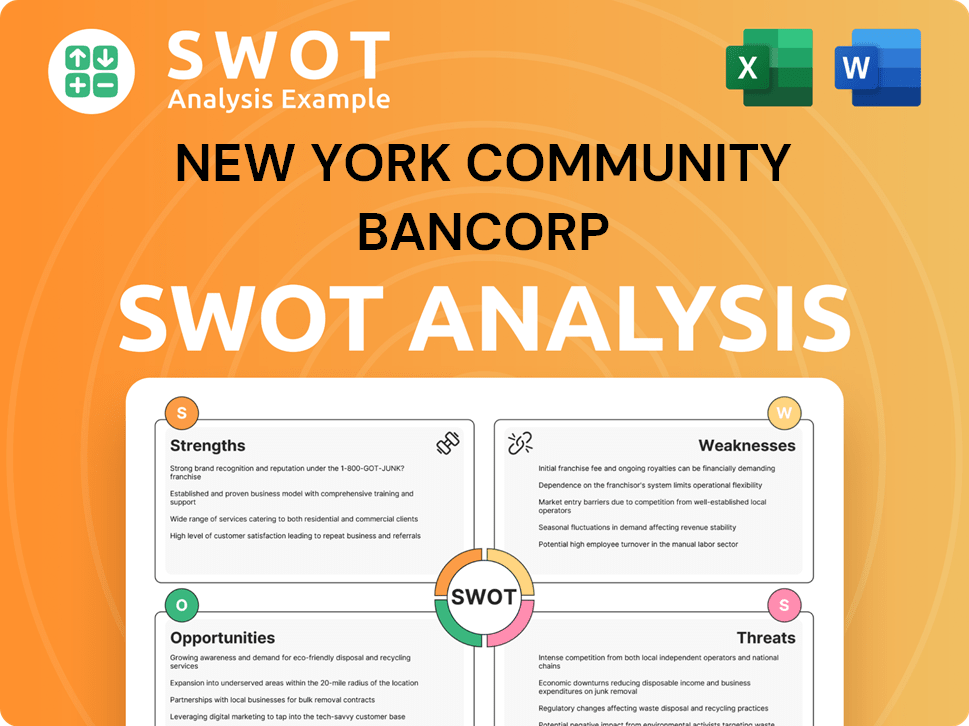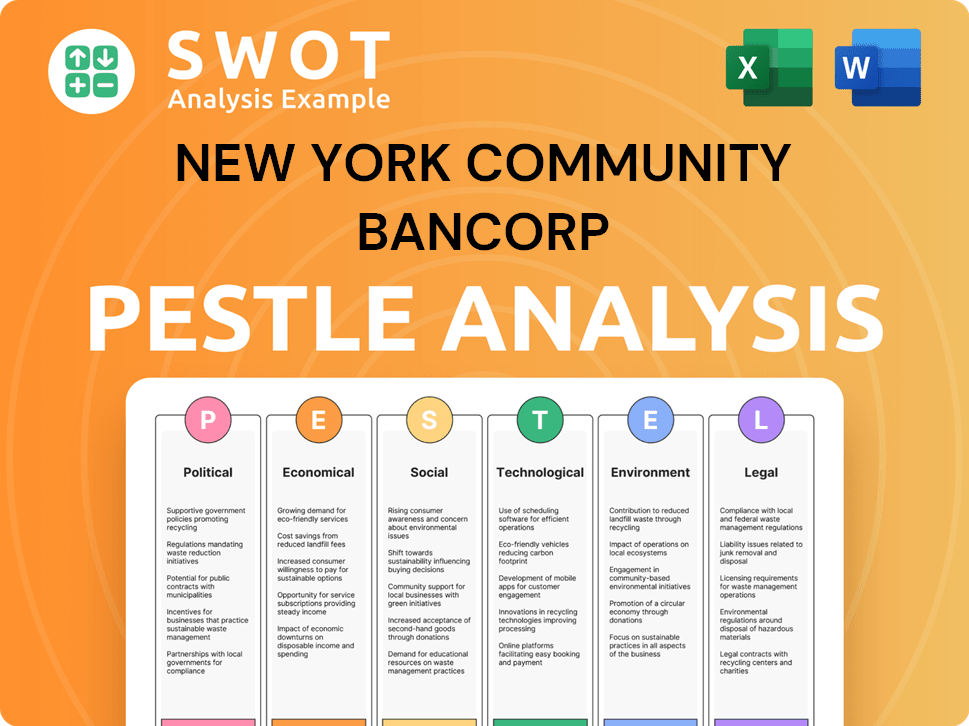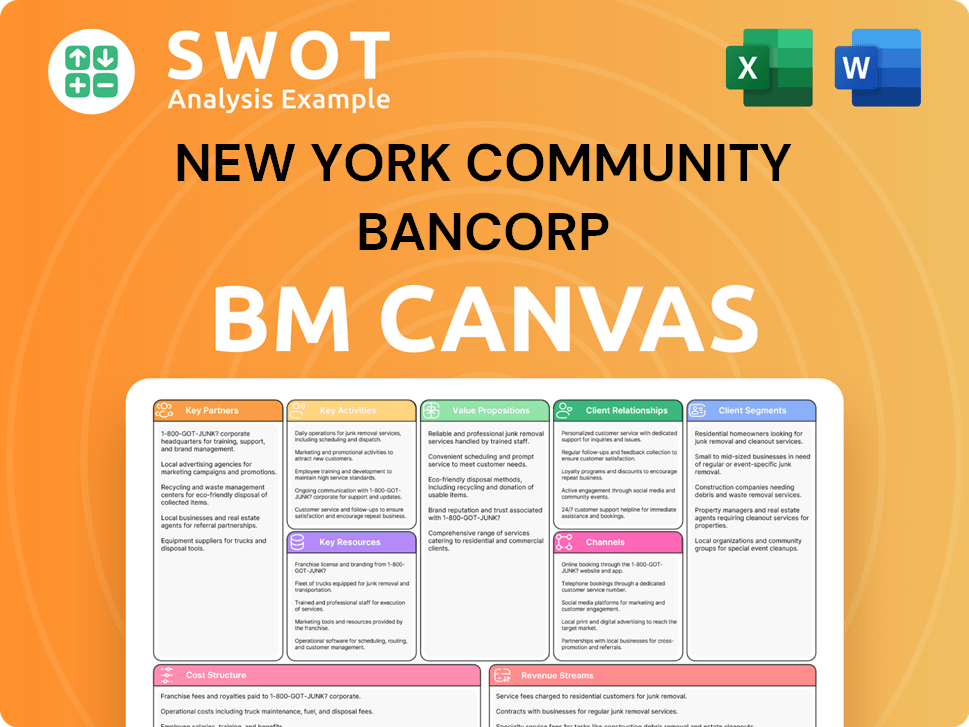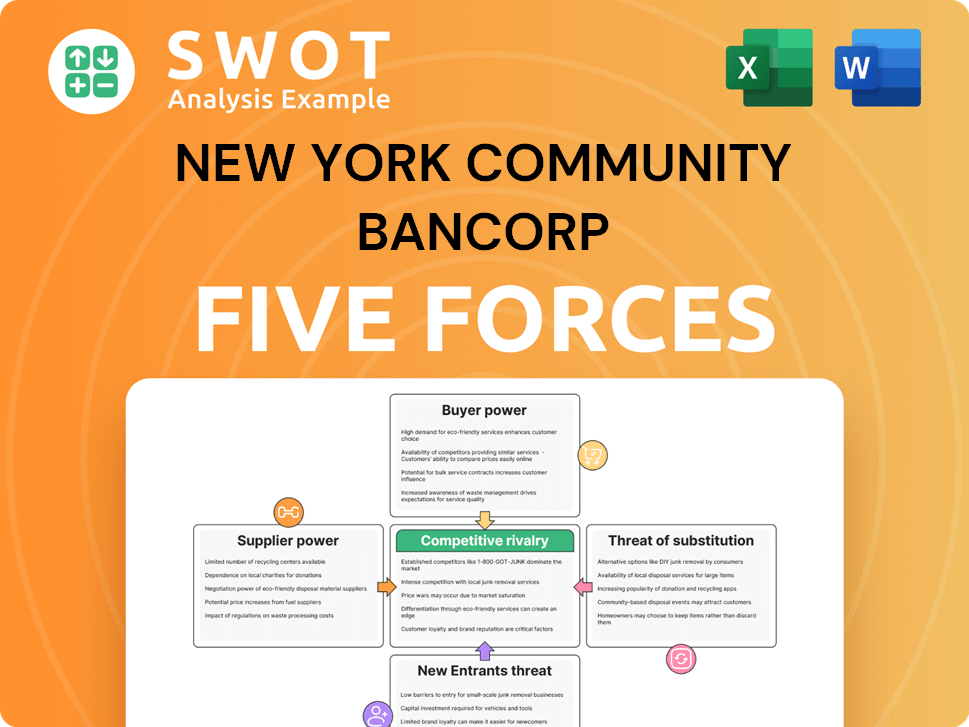New York Community Bancorp Bundle
Decoding NYCB: How Does This Community Bank Operate?
New York Community Bancorp (NYCB) has rapidly ascended the ranks of U.S. banks, becoming a key player in the financial services industry. Its strategic acquisitions, including Flagstar Bank and a portion of Signature Bank, have reshaped its profile and market presence. This makes understanding NYCB's operations more critical than ever for anyone tracking the financial landscape.

As a significant bank holding company, NYCB’s evolution warrants close examination, especially for those considering New York Community Bancorp SWOT Analysis. This analysis will explore how NYCB, a prominent community bank, generates revenue, manages its diverse portfolio of services, and navigates the complexities of the current economic climate. Investors keen on NYCB stock, and those interested in the broader financial sector, will find value in understanding NYCB's strategic direction and financial performance.
What Are the Key Operations Driving New York Community Bancorp’s Success?
New York Community Bancorp (NYCB) creates and delivers value through a diverse range of banking products and services. Its core operations center around serving individual consumers, small businesses, and commercial clients, with a strong presence in the New York metropolitan area. The company's strategy includes multi-family lending, residential mortgage loans, and a comprehensive suite of retail banking services.
Following the acquisitions of Flagstar Bank and a portion of Signature Bank, NYCB expanded its capabilities, including a national mortgage business and a broader commercial banking platform. This expansion has allowed NYCB to diversify its revenue streams and increase its market reach. The company's operational processes involve loan origination, underwriting, deposit gathering, and risk management, all crucial to its financial performance.
NYCB's value proposition lies in its ability to offer tailored financial solutions, competitive rates, and a commitment to community banking, even as it operates on a larger scale. This is supported by its expertise in multi-family lending and its expanded national presence in other key banking sectors. The integration of Flagstar Bank's national mortgage platform has further enhanced its capabilities, allowing it to compete more broadly in the residential mortgage market.
NYCB's core offerings include multi-family lending, residential mortgage loans, and retail banking services. These services are designed to cater to a wide array of customer segments, including individual consumers, small businesses, and commercial clients. The expansion through acquisitions has broadened their service portfolio.
Operational processes include loan origination, underwriting, deposit gathering, and risk management. These processes are crucial for maintaining financial stability and ensuring customer satisfaction. NYCB's distribution networks include physical branches and digital banking platforms.
Customers benefit from tailored financial solutions, competitive rates, and a commitment to community banking. NYCB aims to provide accessible and reliable financial services. This includes a focus on building strong relationships with real estate investors and developers.
The acquisition of Flagstar Bank and a portion of Signature Bank has expanded NYCB's reach. This has led to a national mortgage business and a broader commercial banking platform. This strategic move has diversified NYCB's offerings and increased its market presence.
NYCB's operations are unique due to its expertise in multi-family lending and its expanded national presence. This allows for stable interest income and diversified revenue streams. The company's long-term strategy involves adapting to market changes and enhancing customer value.
- Multi-Family Lending Expertise: NYCB has a long-standing focus on multi-family lending, a specialized market segment.
- Expanded National Presence: The acquisitions have broadened NYCB's footprint, including a national mortgage business.
- Diversified Revenue Streams: NYCB aims to diversify its revenue streams to mitigate risks and enhance financial stability.
- Customer-Centric Approach: NYCB focuses on providing tailored financial solutions and competitive rates.
For further insights, consider exploring the Marketing Strategy of New York Community Bancorp. As of the latest financial reports, NYCB's strategic moves have positioned it to navigate the evolving financial landscape. The company's focus on multi-family lending, combined with its expanded national presence, continues to shape its financial performance. Examining the NYCB stock price today and the latest NYCB stock news provides a current view of the company's market position.
New York Community Bancorp SWOT Analysis
- Complete SWOT Breakdown
- Fully Customizable
- Editable in Excel & Word
- Professional Formatting
- Investor-Ready Format

How Does New York Community Bancorp Make Money?
New York Community Bancorp (NYCB) primarily generates revenue through net interest income. This is the difference between the interest earned on its assets, like loans and investments, and the interest paid on its liabilities, such as deposits and borrowings. Understanding how NYCB makes money is key to evaluating its financial health.
In addition to net interest income, NYCB also earns non-interest income from various services. These include fees from banking services and other charges. Recent acquisitions have expanded NYCB's non-interest income capabilities, especially through mortgage banking services.
The company's monetization strategies focus on attracting deposits to fund lending activities, managing interest rate risk, and strategically growing its loan portfolio. NYCB's focus on multi-family lending has historically provided a stable revenue stream.
Net interest income is the main source of revenue for NYCB. This income stream is derived from the interest earned on loans and investments, minus the interest paid on deposits and borrowings. In the first quarter of 2024, NYCB reported a net interest income of $620 million.
NYCB's loan portfolio is a key driver of its net interest income. The portfolio includes multi-family loans, commercial real estate loans, and residential mortgages. The composition of the loan portfolio affects the overall risk and return profile of the bank.
Non-interest income provides additional revenue streams. This includes fees from banking services, such as deposit account fees and ATM fees. The acquisition of Flagstar Bank has expanded non-interest income through mortgage banking and other fee-based services.
Attracting and retaining deposits is crucial for funding lending activities. NYCB's ability to manage its deposit base impacts its funding costs and profitability. Effective deposit management is a key part of its monetization strategy.
Managing interest rate risk is essential for protecting profitability. NYCB employs strategies to mitigate the impact of fluctuating interest rates on its net interest margin. This involves careful management of assets and liabilities.
Strategic expansion of the loan portfolio is a key monetization strategy. NYCB aims to grow its loan book while maintaining a balance between risk and return. Diversification of the loan portfolio, such as through the acquisition of Flagstar Bank, is also a focus.
NYCB is diversifying its revenue streams to reduce its reliance on multi-family lending. The acquisition of Flagstar Bank and parts of Signature Bank has expanded its non-interest income capabilities and its presence in the national mortgage market. This diversification aims to enhance profitability and reduce reliance on a single segment. Further insights can be found in the Competitors Landscape of New York Community Bancorp.
- The acquisition of Flagstar Bank brought a significant mortgage origination and servicing platform.
- Diversification into commercial banking and national mortgage markets aims to stabilize and grow revenue.
- Strategic moves are designed to enhance overall financial performance and reduce risk.
- Managing interest rate risk remains a core focus to protect profitability.
New York Community Bancorp PESTLE Analysis
- Covers All 6 PESTLE Categories
- No Research Needed – Save Hours of Work
- Built by Experts, Trusted by Consultants
- Instant Download, Ready to Use
- 100% Editable, Fully Customizable

Which Strategic Decisions Have Shaped New York Community Bancorp’s Business Model?
New York Community Bancorp (NYCB) has undergone significant strategic shifts, notably through acquisitions that have reshaped its market position. These moves have propelled NYCB into a prominent spot among U.S. banks, expanding its capabilities and customer reach. Understanding these key milestones and strategic decisions is crucial for assessing NYCB's current standing and future prospects.
The company's journey includes major acquisitions that have broadened its service offerings and geographic footprint. These strategic actions have been pivotal in shaping NYCB into a more diversified financial institution. The following sections will delve into the specific moves and their impact on the company's competitive edge.
NYCB's evolution reflects its adaptation to market dynamics and its efforts to enhance shareholder value. This includes navigating challenges and capitalizing on opportunities within the financial services sector. The following sections will provide a detailed look at the company's strategic initiatives and their outcomes.
A critical milestone for New York Community Bancorp was the acquisition of Flagstar Bank in December 2022, which significantly increased its asset size and diversified its business lines. This was followed by the acquisition of a portion of Signature Bank in March 2023, further expanding its deposit base and commercial banking capabilities. These moves have positioned NYCB as a top 20 bank in the U.S. by assets.
NYCB's strategic moves have focused on expanding its scale and scope through acquisitions. The integration of Flagstar Bank and Signature Bank demonstrates its commitment to growth and diversification. These acquisitions have allowed NYCB to enhance its service offerings and strengthen its market position. The acquisitions have led to a more diversified loan portfolio and a broader national footprint.
NYCB's competitive advantage lies in its established presence in the multi-family lending market, particularly in the New York metropolitan area. The acquisitions have enhanced its competitive edge by providing greater scale and a national footprint. The company continues to adapt to new trends by focusing on strengthening its balance sheet and optimizing operational efficiency.
In early 2024, NYCB secured a $1 billion equity investment from a group of investors, including former Treasury Secretary Steven Mnuchin, which significantly bolstered its capital position. This strategic capital injection was crucial in addressing market concerns and providing a stronger foundation for future growth. For more details, you can read about the Growth Strategy of New York Community Bancorp.
As of Q1 2024, NYCB reported a net loss, reflecting the challenges of integrating recent acquisitions and managing interest rate risks. However, the capital infusion has provided a buffer. The bank's focus remains on improving operational efficiency and strengthening its balance sheet.
- The acquisitions of Flagstar and Signature Bank significantly increased NYCB's assets.
- NYCB's multi-family lending expertise in the New York area provides a stable customer base.
- The bank is working to improve its financial performance through strategic initiatives.
- The equity investment has helped stabilize the bank's capital position.
New York Community Bancorp Business Model Canvas
- Complete 9-Block Business Model Canvas
- Effortlessly Communicate Your Business Strategy
- Investor-Ready BMC Format
- 100% Editable and Customizable
- Clear and Structured Layout

How Is New York Community Bancorp Positioning Itself for Continued Success?
New York Community Bancorp (NYCB) holds a significant position in the U.S. banking sector, especially after its strategic acquisitions. As of March 31, 2024, its assets totaled $112.9 billion, positioning it among the larger regional banks. The company has a strong market share in specific areas, such as multi-family lending in the New York metropolitan area. Its expansion through Flagstar Bank has broadened its customer base and reduced concentration risk.
Despite its strengthened position, NYCB faces several key challenges. These include interest rate fluctuations, credit risk within its loan portfolio, especially in commercial real estate, and regulatory changes. Competition from larger and smaller banks also remains a constant factor. The Brief History of New York Community Bancorp shows how the company has navigated past challenges. The company's stock experienced volatility in early 2024, prompting a $1 billion equity investment to address concerns about its loan portfolio and capital levels.
NYCB's strategic acquisitions have significantly boosted its industry presence. The company is a notable player in the U.S. banking landscape. It has a strong foothold in multi-family lending within the New York metropolitan area.
NYCB faces risks from interest rate changes and credit quality, particularly in commercial real estate. Regulatory changes and competition from other banks also pose challenges. The company's stock can be subject to volatility based on market conditions and investor sentiment.
NYCB is focused on strengthening its balance sheet and improving operational efficiency. The company aims to leverage its diversified revenue streams. Its future depends on successful integration, effective loan portfolio management, and adaptation to the changing economic and regulatory environment.
NYCB offers a range of financial services. These services include traditional banking products and specialized offerings. Its expanded operations provide a broader range of services to its customers. The company's focus is on delivering long-term value to its shareholders.
NYCB's strategic initiatives include strengthening its balance sheet and optimizing operational efficiency. The company is focused on integrating recent acquisitions to achieve full synergies. The goal is to sustain and expand its ability to generate revenue through diversified streams.
- Enhancing capital levels.
- Improving asset quality.
- Streamlining operations.
- Expanding market reach.
New York Community Bancorp Porter's Five Forces Analysis
- Covers All 5 Competitive Forces in Detail
- Structured for Consultants, Students, and Founders
- 100% Editable in Microsoft Word & Excel
- Instant Digital Download – Use Immediately
- Compatible with Mac & PC – Fully Unlocked

Related Blogs
- What are Mission Vision & Core Values of New York Community Bancorp Company?
- What is Competitive Landscape of New York Community Bancorp Company?
- What is Growth Strategy and Future Prospects of New York Community Bancorp Company?
- What is Sales and Marketing Strategy of New York Community Bancorp Company?
- What is Brief History of New York Community Bancorp Company?
- Who Owns New York Community Bancorp Company?
- What is Customer Demographics and Target Market of New York Community Bancorp Company?
Disclaimer
All information, articles, and product details provided on this website are for general informational and educational purposes only. We do not claim any ownership over, nor do we intend to infringe upon, any trademarks, copyrights, logos, brand names, or other intellectual property mentioned or depicted on this site. Such intellectual property remains the property of its respective owners, and any references here are made solely for identification or informational purposes, without implying any affiliation, endorsement, or partnership.
We make no representations or warranties, express or implied, regarding the accuracy, completeness, or suitability of any content or products presented. Nothing on this website should be construed as legal, tax, investment, financial, medical, or other professional advice. In addition, no part of this site—including articles or product references—constitutes a solicitation, recommendation, endorsement, advertisement, or offer to buy or sell any securities, franchises, or other financial instruments, particularly in jurisdictions where such activity would be unlawful.
All content is of a general nature and may not address the specific circumstances of any individual or entity. It is not a substitute for professional advice or services. Any actions you take based on the information provided here are strictly at your own risk. You accept full responsibility for any decisions or outcomes arising from your use of this website and agree to release us from any liability in connection with your use of, or reliance upon, the content or products found herein.